Table of Contents
CBSE Sample Papers for Class 12 Economics Compartment Outside Delhi -2010
Time allowed : 3 hours Maximum marks 100
GENERAL INSTRUCTIONS
- All questions in both the sections are compulsory.
- Marks for questions are indicated against each.
- Questions No. 1-5 and 17-21 are very short-answer questions carrying 1 nick each. They are required to be answered in one sentence each.
- Questions No. 6-10 and 22-26 are? short-answer questions carrying 3 marks each. Answers to them should normally not exceed 60 words each.
- Questions No. 11-13 and 27-29 are also short-answer questions carrying 4 marks each. Answers to them should normally not exceed 70 words each.
- Questions No. 14-16 and 30-32 are long-answers questions carrying 6 marks each. Answers to them should normally not exceed 100 words each.
- Answers should be brief and to the point and the above word limit should be adhered to as far as possible.
SET I
SECTION A
Question.1. Define production possibilities curve.
Answer. Production possibility curve is a curve which graphically represents various combinations of two commodities which can be produced with the available resources and technology.
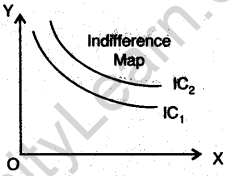
Question.2. What is an indifference map?
Answer. An indifference map contains more than one indifference curve representing different levels of satisfaction.
Question.3. Define utility.
Answer. Utility is the want satisfying power of a commodity or a service.
Question.4. Give two examples of fixed cost
Answer. Two examples of fixed cost are:
(i) rent of the building; .
(ii) salary of the security guard posted at the gate.
Question.5. Give meaning of monopolistic competition.
Answer. Monopolistic competition is a market situation where there is a large number of buyers and few sellers and the products are differentiated on the basic of colour, packing, brand etc.
Question.6. Explain the meanings of positive economics and normative economics.
Answer. (Out of syllabus for 2012 examination and on wards)
Or
Explain the problem of ‘how to produce’.
Answer. See Q. 10, 2008 (U Delhi)
Question.7. Explain the effect of rise in income of a consumer on his demand for a good.
Answer. Consumer’s income influences the demand for commodities. As a result of increasing income, other things remaining the same, demand increases at the same price, with the result that demand curve shifts towards right as shown in the diagram. When rise in income is the cause of increase in demand for a commodity, then it is called a normal good, e.g., fruits.
However, in case of inferior goods, rise in income of the consumer will reduce the demand for inferior good’s e.g., millets, coarse cloth.
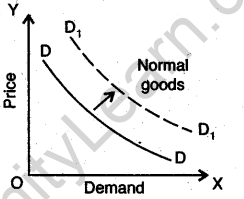
Question.8. What is law of demand? Prepare a demand schedule based on the law of demand.
Answer. Law of demand states that quantity demanded of a commodity is inversely related to the price of the commodity, other things being constant. This means that when price falls, demand for the commodity increases and vice-versa. The inverse relationship between price and quantity demanded can be explained with the help of a demand schedule.
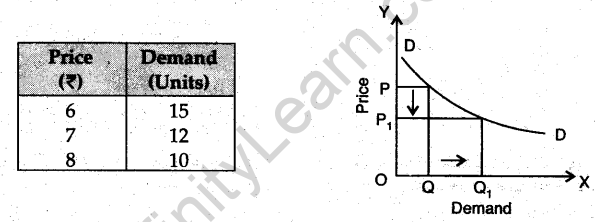
According to die schedule, when price is Rs. 6, demand is 15 units end when price increases to Rs. 8, demand falls to 10 units. According to the diagram, demand curve DD slopes downwards to right indicating that when price falls demand increases and vice-versa.
Question.9. What is ‘increase in supply’? State any two factors that can causerie.
Answer. Increase in supply means more supply because of the changes in factors other than price. In the case of increase in supply, as indicated in the diagram, supply curve shifts towards right. The two factors, which can cause increase in supply, are:
(i) fall in the price of inputs, and
(ii) improvement in the technology.

Question.10. Given equilibrium in the^market, explain the chain of effects of ‘increase’ in demand of a good.
Answer. Chain of effects when demand for commodity X increases as supply remains unchanged,
• there would be excess demand, at the given price.
• As a result supply starts expanding due to law of supply.
• Due to rise in price, demand starts contracting as per the law of demand.
These changes continue till the new equilibrium price is established where demand equals supply.
Therefore, the equilibrium price rises and equilibrium quantity also increases.
Question.11. Calculate price elasticity of demand by the percentage method:
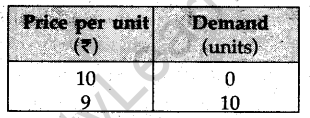
Answer.


Question.12. A producer can sell more of a good only by lowering the price. Prepare a Total Revenue and Marginal Revenue Schedule. Take four output levels.
Answer.

Or
A producer can sell more of a good at the same price. Prepare a Total Revenue and Marginal Revenue Schedule. Take four output levels.
Answer. See Q. 12, 2010 (I Comptt. Delhi)
Question.13. Prepare a Marginal Product Schedule when for increasing production only one input is increased. Indicate the phases of the Law of Variable Proportions.
Answer. See Q. 15, 2008 (I Delhi)
Question.14. A consumer consumes only two goods. Explain the conditions of consumer’s equilibrium with the help of Indifference curve analysis.
Answer. See Q. 14, 2010 (I Delhi)
Question.15. Explain the ‘Marginal Cost and Marginal Revenue’ approach for producer’s equilibrium With the help of a schedule.
Answer. See Q. 16 (Or), 2010 (I Delhi)
Question.16. Explain the implications of the following features of a perfectly competitive market:
(i) Perfect knowledge about the market of the good.
(ii) Perfect knowledge about the inputs used in the production of the good
Answer. (i) In a perfectly competitive market, the number of buyers and sellers is very large and all the buyers and sellers have complete knowledge about the market. With the result no individual buyer or seller can influence the price in the market.
(ii) Another important characteristic of perfect competition is that products are homogeneous and carry the same price. By implication, this means the cost of the inputs used by the producers will be same. As a result of this all the sellers have perfect knowledge about the inputs used in the production.
Or
Explain the implications of the following two features of oligopoly market:
(i) Few firms
(ii) Barriers to the entry of firms
Answer. (i) Few firms: There are few sellers of the commodity and each sells ,a substantial portion of the output of the industry. The implication of this feature is that the demand curve faced by each firm is downward sloping indicating that each firm has : substantial power to influence the price or output.
(ii) Barriers to the entry of firms: Barriers to the entry of firms can be natural like requirements of huge capital or operating at minimum average cost or. artificial barriers due to patent rights which “‘prevent entry of new firms in the industry.
SECTION B
Question.17. Define capital goods.
Answer. Those goods which are man-made and are used for further production are Capital Goods, such as machines.
Question.18. Name the two components of money supply.
Answer. The two components of money supply are currency with the public and demand deposits.
Question.19. What are demand deposits?
Answer. Demand deposits are those bank deposits which can be withdrawn by the depositors at any time they want.
Question.20. Define ‘revenue receipts’ in a government budget.
Answer. Revenue receipts are those which government obtains without incurring any liability or reducing any asset, such as tax revenue.
Question.21. What is trade balance ?
Answer. Trade balance, also known as balance of trade refers to the difference in the value of imports and exports of visible items only, i.e., material goods.
Question.22. In an economy, the consumption expenditure is Rs 8,750 crores and the ratio of average propensity to consume and average propensity to save is 7 : 1. Calculate the level of income in the economy.
Answer.

Question.23. In an economy, investment is increased by Rs 2,000 crores. Calculate the change in total income, if marginal propensity to save is 0.25.
Answer.
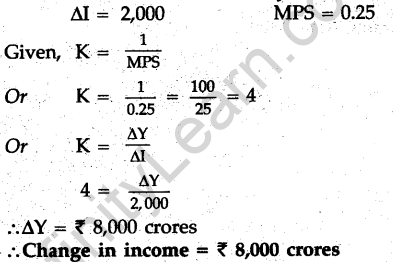
Question.24. Give the meaning of revenue expenditure and capital expenditure. Give one example of each.
Answer. See Q. 26, 2008 (I Outside Delhi)
Or
Explain ‘reducing inequalities’ objective of a government budget.
Answer.’See Q. 24, 2009 (I Delhi)
Question.25. Explain the concept of ‘surplus’ in the: balance of payments account.
Answer. The balance of payments is in surplus if the autonomous receipts are greater than autonomous payments. This means that the domestic country has some net claims against the foreign country.
Question.26. What is meant by appreciation and depreciation of domestic currency? Explain.
Answer. In currency, depreciation, there is a fall in the value of domestic currency in terms of foreign currency. In currency appreciation, there is a rise in the value of domestic currency in terms of foreign currency.
Question.27. Distinguish between ‘intermediate and final goods’. Give two examples of each.
Answer. See Q. 25 (Or), 2009 (I Delhi)
Or
Giving reason, explain how are the following treated in estimation of national income by the income method:
(i) Interest paid by banks of depositors.
(ii) National debt interest.
Answer. (i) Interest paid by banks to the depositors is included, because it is the income earned by the depositors and the Banks use these deposits for business purposes.
(ii) National debt interest is not included, as the government takes the loan for both productive and non-productive purposes: It is a transfer payment, hence it is not included.
Question.28. Calculate Gross National Disposable Income and Personal Income:
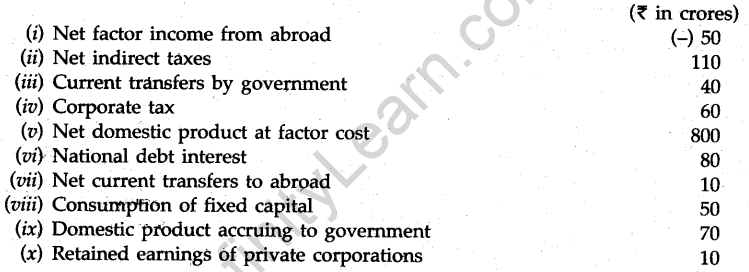
Answer.
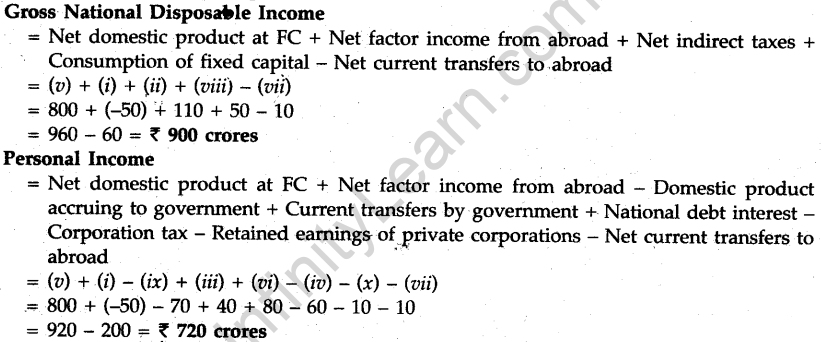
Question.29. What is a government budget? Explain the meanings of fiscal deficit and primary deficit?
Answer. Government budget: “A government budget is an annual financial statement showing item- wise estimates of expected revenue and anticipated expenditure during a fiscal year.” It is a statement of estimates of government receipts and expenditure. Budget estimates pertain to a fixed period, generally a year.
Fiscal Deficit: It is the excess of total expenditure over total receipts Of the government. Fiscal Deficit = Total or Budget Expenditure – Total or Budget Receipts other than borrowings
Fiscal deficit is estimated to know about the extent of borrowing by the government. Primary Deficit : Primary deficit is measured by fiscal deficit less interest payments on previous borrowings.
Primary Deficit = Fiscal Deficit – Interest payments Primary deficit indicates the amount of borrowing the government is going to meet its expenses other than interest payments.
Question.30. Calculate ‘Net Domestic Product at Factor Cost’ by the expenditure method and the production method:
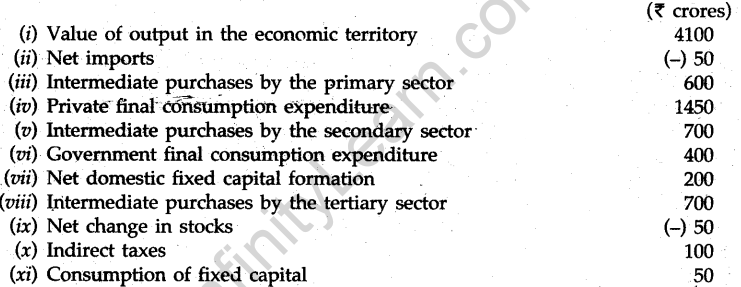
Answer.
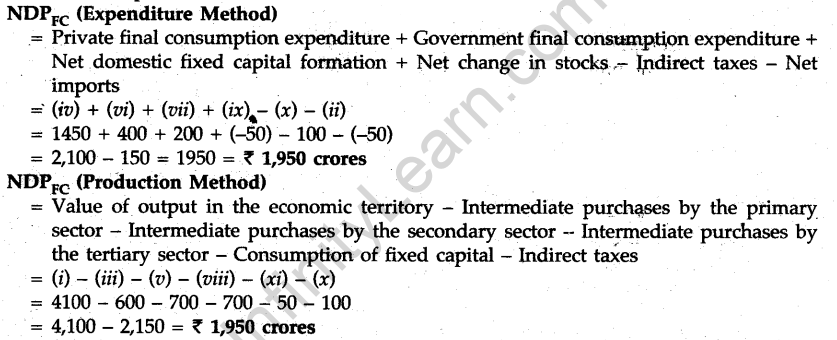
Question.31. Explain the process of deposit creation by the commercial banks with the help of a numerical example.
Answer. Commercial banks accept deposits from the general public known as primary deposits and , keeping a percentage of these deposits in reserve (known as Legal Reserve Ratio), advance the balance of the deposits to other customers. While advancing them loans banks deposit the amount in their accounts and again keeping a percentage of the deposits (Legal Reserve Ratio), further advance the balance amount to others. This process continues and is known as credit creation by banks. In this way banks create credit many times more than the primary deposits.
The phenomenon of credit creation can be explained by taking a hypothetical example, where primary deposit is Rs 1000 and legal, reserve ratio (LRR) is 20%. Say, Mr A deposits Rs 1000. Keeping Rs 200 (20%) in reserve, the balance of Rs 800 is advanced as loan to B. Keeping Rs 160.(20% of Rs 800) in reserve, the balance of Rs 640 is advanced as loan to C. This process continues and finally total deposits created are Rs 5,000, i.e. 5 times more. So money multiplier is 5. This process becomes clear, looking at the schedule given below:
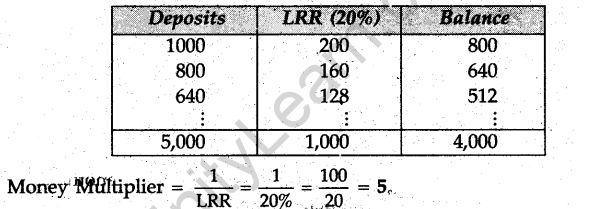
Question.32. Define and represent deflationary gap on a diagram. Explain the role of Bank Rate in removing it.
Answer. When equilibrium takes place before the stage of full employment, this is a case of deficiency in demand. At this level, aggregate demand is less than aggregate supply at full employment level of output and deflationary gap prevails-. Because of this, given resources of an economy are not fully utilized. Therefore, in such a situation necessary fiscal and monetary measures should be taken so that there is increase in the level of aggregate demand. For doing this bank rate policy of the central bank of a country can play an important role. In such a situation bank rate should be reduced so that interest rate falls and demand for funds increases. In this way aggregate supply will increase matching to the level of aggregate demand.
The concept of deflationary gap can be explained with the help o^the given diagram. In the diagram the equilibrium level of output is OQ but the full employment level of output is OZ. At this level aggregate demand falls short of aggregate supply = EF. This is deflationary gap.
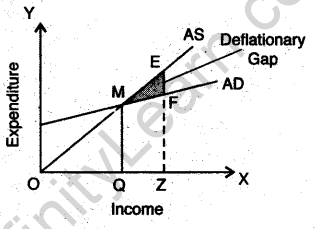
Or
Define and represent inflationary gap on a diagram. Explain the role of ‘Open Market Operations in removing it.
Answer. When equilibrium level of income takes place after the stage of full employment, this is a case of excess demand. In this case, at the full employment, level of output, aggregate demand is more than aggregate supply. The excess of aggregate demand over the excess of aggregate supply is the inflationary gap.
This gap should be reduced but for doing this aggregate supply cannot be increased because the stage of full employment has been arrived at. Therefore, for bringing up equality between aggregate demand and aggregate supply, aggregate demand should be reduced.
Open market operations can be used as a monetary tool for doing this. Central bank should sell securities in die open market which will be bought by the commercial banks leading to a fall in their cash reserve. As such they will give less credit. Finally aggregate demand will be reduced.
The inflationary gap can be shown in the given diagram. In the diagram equilibrium level of output is OQ whereas full employment level of output is OZ. At flits level aggregate demand is more than aggregate supply i.e., EF.EF is inflationary gap.
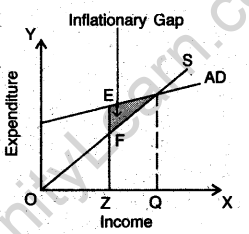
SET II
Note : Except for the following questions, all the remaining questions have been asked in Set I.
SECTION A
Question.7. Explain, by giving an example, how is demand for a good affected when price of its substitute rises.
Answer. Substitute goods are those goods which can be used in place of one another^ When there is an increase in the price of a substitute, the demand for the main commodity will increase. For example, when the price of coffee increases, the demand for tea will increase because now tea becomes a cheaper relative to coffee.
Question.12. Calculate price elasticity of demand by the percentage method:
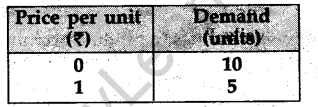
Answer.
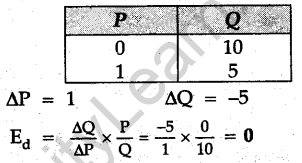
Question.20. Define direct tax.
Answer. Direct tax is a tax whose burden cannot be shifted to others. In short, the burden of this tax is finally borne by those upon whom it is levied, for example income tax.
Question.23. Find the value of multipliers given (i) marginal propensity to consume = 1 and (ii) marginal propensity to save = 1.
Answer.

SECTION B
Question.26. In an economy total savings are Rs 2,000 crores and the ratio of average propensity to save and average propensity to consume is 2 : 7. Calculate the level of income in the economy.
Answer.

Question .29. Calculate Net National Disposable Income and ‘Personal Disposable Income’:

Answer.
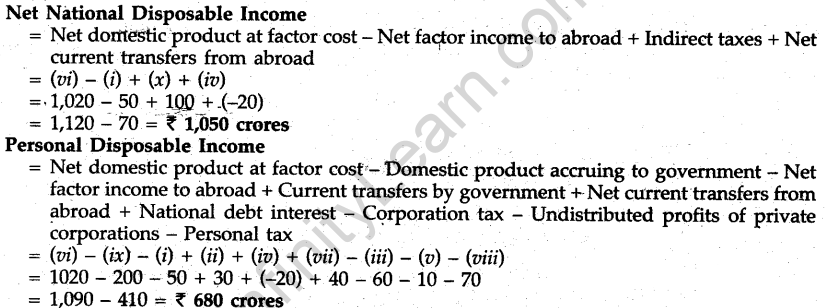
Question.31. Calculate Net Domestic Product at Factor Cost by (a) income method and (b) production method from the following data:
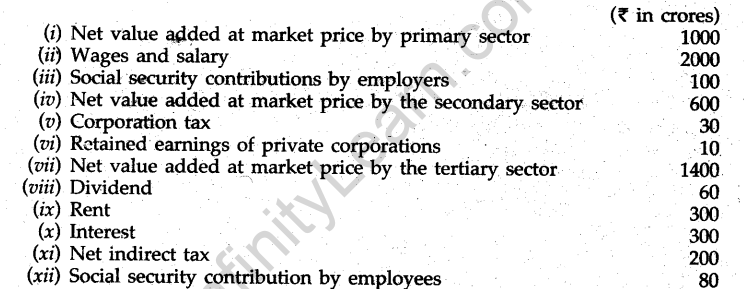
Answer.




